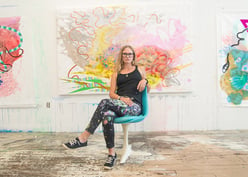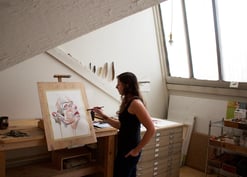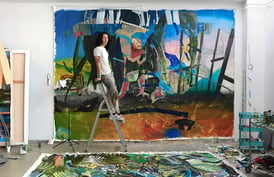Carson Fox’s goal is for her work to seem preposterous and wondrous, to underscore that nothing is more perplexing, complex, and extraordinary than nature. She creates beautiful sculptures and installations pieces exclusively with brightly colored resin that can be categorized into three main bodies of work: plant, sea, and rock forms. Her works are typically wall-mounted and composed of hundreds of small parts to create the whole.
Can you tell us about your work?
I am primarily a sculptor, and while I make plenty of stand-alone sculptures, my studio has specialized in site-specific installations for a number of years. For the three main bodies of work that I create, flowers particularly interest me because of their potential as vehicles for riotous color when I assemble them into wall installations composed of hundreds of pieces. Plant forms include cross-sections of wood, sticks, and grasses. Recently, I have begun making lacy vines that reach around curved walls and into spaces traditional artwork cannot. Coral and rock forms draw upon themes of continuance, as they refer to objects that are thousands of years old.
My free-standing sculptures are typically quite brightly hued and are made from poured, carved, and manipulated resin dusted with vibrant layers of raw pigment, flocking, and sand. The forms suggest the animation of figuration but omit a sum of recognizable parts. A gesture remains, and color-saturated abstraction occupies the rest.
Can you tell us about your process?
My installations are usually comprised of hundreds of small parts that are arranged together on site. This process begins in the studio with hand-sculpted forms in oil clay. Next, I make molds from the objects that allow me to make multiple pieces later that fit together to create limitless variations. Installation projects require a good deal of labor which I thrive upon; the meditative rhythms of the work allow me to gather creative steam.  Can you tell us about your journey to becoming a professional artist?
Can you tell us about your journey to becoming a professional artist?
I decided around the age of five I was going to be an artist. My dad was an art history professor, so I realized at an early age you could actually be an artist and so that was what I set my sights on.
When you are looking for inspiration, what resources do you turn to?
My natural inclination is to be interested in objects and themes that have been left out of the history of art, feeling a particular kinship with marginalized “craft” materials, vintage illustrations, folk art, and material culture of bygone eras. I make it a habit to roam flea markets and antique stores on a regular basis looking for things that cry out for my attention for one reason or another. Sometimes the object will languish for a long time in my possession before I understand its relationship to my work. For example, the resin flowers I make were first inspired by a collection of antique curtain tie-backs. Many were flower-shaped and functioned by being pressed directly into the wall through the curtain. My own resin flowers are cast on heavy pins that permit a similar mode of installation but exist en masse like an unruly flowerbed.
Walk us through a typical day in your studio. What is your routine? Has it changed in the past year?
I usually arrive at my studio between 8:30 and 9 am. Once there, I change my clothing (everything I do seems to get messy) and take a look around, paying special attention to my first impressions. Often, things I thought were a disaster the day before look very different the following morning. I sit down with a small book I carry around and write down everything I hope to accomplish that day, plus other boring stuff that might weigh upon me. These dull, day-to-day responsibilities- picking up dog food, getting carrots for dinner, etc. can distract me if they aren’t memorized on paper and put in their proper place: to be addressed after the studio day is done. I cross out accomplished things with pleasure. Then I get to work. What I do depends entirely upon what projects are on the table and may range from casting resin to building new forms. Around noon I eat and briefly scan email and social media. At 12:30 I am working again and I leave the studio between 5 and 7 pm. The time flies.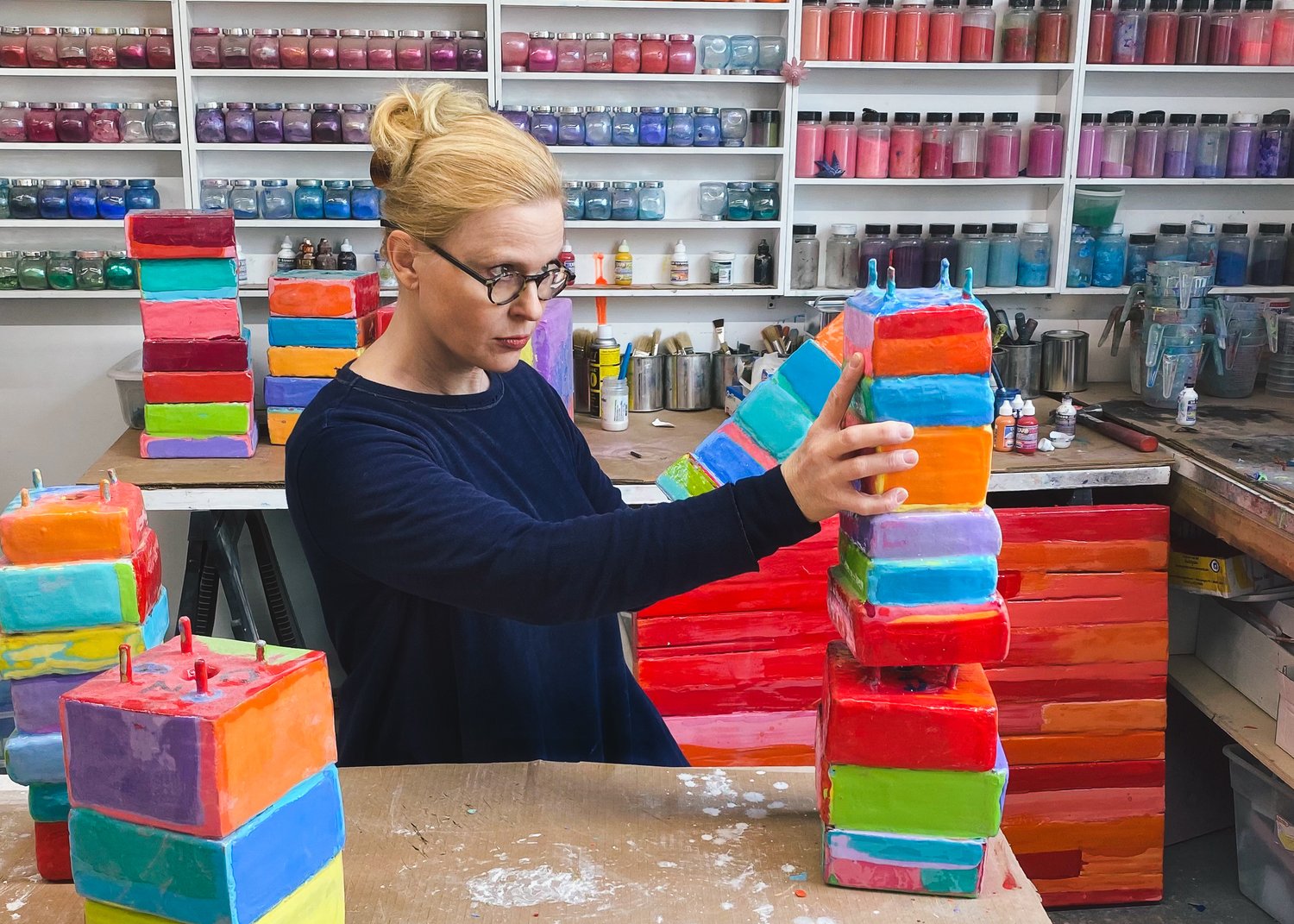 Finding the right rhythm to be productive in the studio can be a challenge, what advice do you have for staying productive and focused?
Finding the right rhythm to be productive in the studio can be a challenge, what advice do you have for staying productive and focused?
Routine is very important, as is treating studio time with a workmanlike attitude. On scheduled studio days, I go whether I feel like it or not, and I get there on time. I never wait for inspiration. This is essential for me, as my creative momentum is gained through the actual process of work.
What advice do you have for combating creative block?
Work is always the answer for me, even if it is bad. Bad work often acts as a bridge between upswings, and I consider these as periods of growth. Growth with anything often isn’t pretty and tends to be like real physical growth- awkward and unpredictable with sharp jabs of pain here and there. I tell myself this is natural and impossible to avoid. Even if I hate it, I work, and inevitably I get ideas that ignite real enthusiasm, and suddenly I am excited again about what I am doing. You can always throw the bad things out.
As an artist, how do you measure success? Can you recall a specific event in your career that made you feel successful?
I had a professor in undergraduate school who told me that successful artists were those who managed to be in the studio no less than three days a week. At the time, this equation seemed a bit simplistic to me, but as I get older I appreciate his wisdom. There have been a number of excellent things that have happened during my career- public art projects, large commissions, and good shows, but when I get down to it, the moments I feel deep satisfaction are always in the studio, and that is success to me. 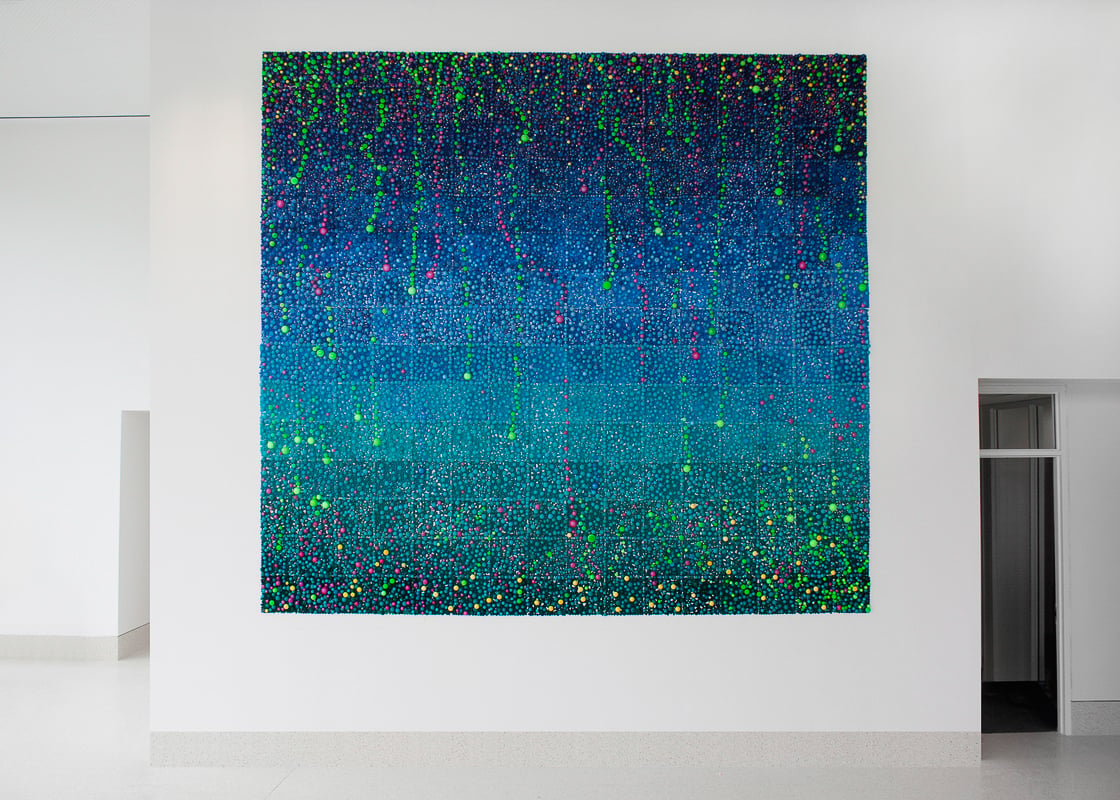 How do you see the art market changing? Where you do see yourself in this transition?
How do you see the art market changing? Where you do see yourself in this transition?
I see the gallery system shrinking as art fairs, art consulting, and online sales gain hold. I have already experienced this with at least two galleries with whom I have worked: they have closed their “store-fronts” and are working independently to sell works. In my own studio, I increasingly depend on an expanding pool of art consultants, advisors, dealers, and designers to place my work, and my focus is more project-based than exhibition-centric.
What advice do you have for artists who are beginning to build their careers? Have there been any habits or strategies that you have adopted that you feel have created more opportunities or visibility for your work?
Make what you want to make. When I first started making installations, I was told by dealers that I needed to find a way to make my work movable, as no one would buy them otherwise but what I discovered was I had the wrong dealers. I knew there was an audience out there who would support me if I just kept at it, and lo and behold, we eventually found each other.
Be ethical and consistent with your business dealings. The art world is built on trust and relationships: it is essential to be worthy of that trust. Get things done on time. Deliver on time. Do what you say you will do.
Keep at it. There will be times when you can’t get to the studio as much as you like. This is painful, but you need to keep working toward the goal of your art career becoming your primary activity. A little bit of work is better than none: keep an active sketchbook, make smaller projects and never stop thinking about it.
Do you consider yourself, and all artists, to be entrepreneurs? Why or why not?
All artists must be entrepreneurs on some level because they are in business for themselves, like it or not. However, the inventiveness and engagement of how much an artist pursues this part of their career depend on the artist. We are all different: some find the business end of artmaking thrilling and fun, and others are begrudging as they tend to this part of their practice.
Failure is an inevitable part of success in any field. Do you have advice for overcoming setbacks?
Failure is an inevitable part of any success. One reason is simple scarcity: if you were always successful, you would quickly exhaust all opportunities available. We artists have to take turns.
However, failure is also valuable for teaching us how to get better. For every show or commission, I record some post-mortem notes: things I did wrong that I should avoid in the future. There is always something I can improve.
Failure can also be perceived because not everyone may like your work. Maybe you didn’t get that grant, that show, or residency. It is fruitless to worry about this, as there will always be people who don’t connect with your work. You must develop thick skin.
“Failure” all boils down to: is it useful? If it can teach you, pay attention. If not, forget all about it and move on.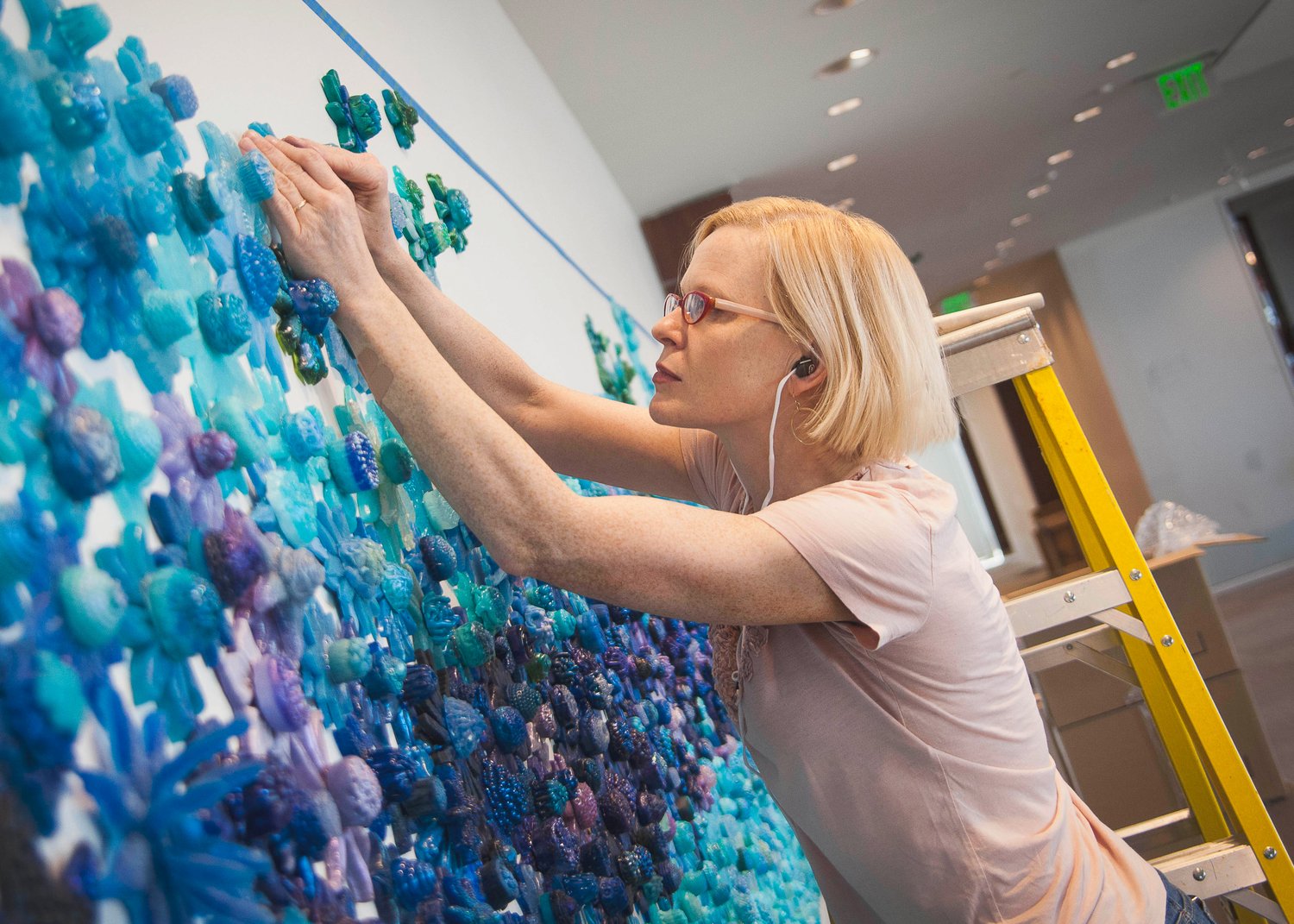 What sparked your interest in partnering with TurningArt?
What sparked your interest in partnering with TurningArt?
TurningArt clearly has a deep interest and concern for the artists it represents that sets it apart from other art companies. You can see this in their outreach and the materials they regularly disseminate. The fact that TurningArt tries to imagine multiple ways to generate revenue for artists - from leasing, sales, and commissions - reveals a network that thinks creatively about how to work with creative people.
What does having your artwork in the workplace and other commercial or public spaces mean to you?
I find it deeply satisfying to have my work placed in public spaces, as it gives my work the ability to be part of people’s day-to-day lives. Often during installation, I meet the folks who use the environments where my works are placed and I am always impressed by their excitement in having art in their spaces. People want art in their lives.
To see more featured TurningArtists, return to our blog. To get Carson's art in your space, set up a free consultation with an Art Advisor here!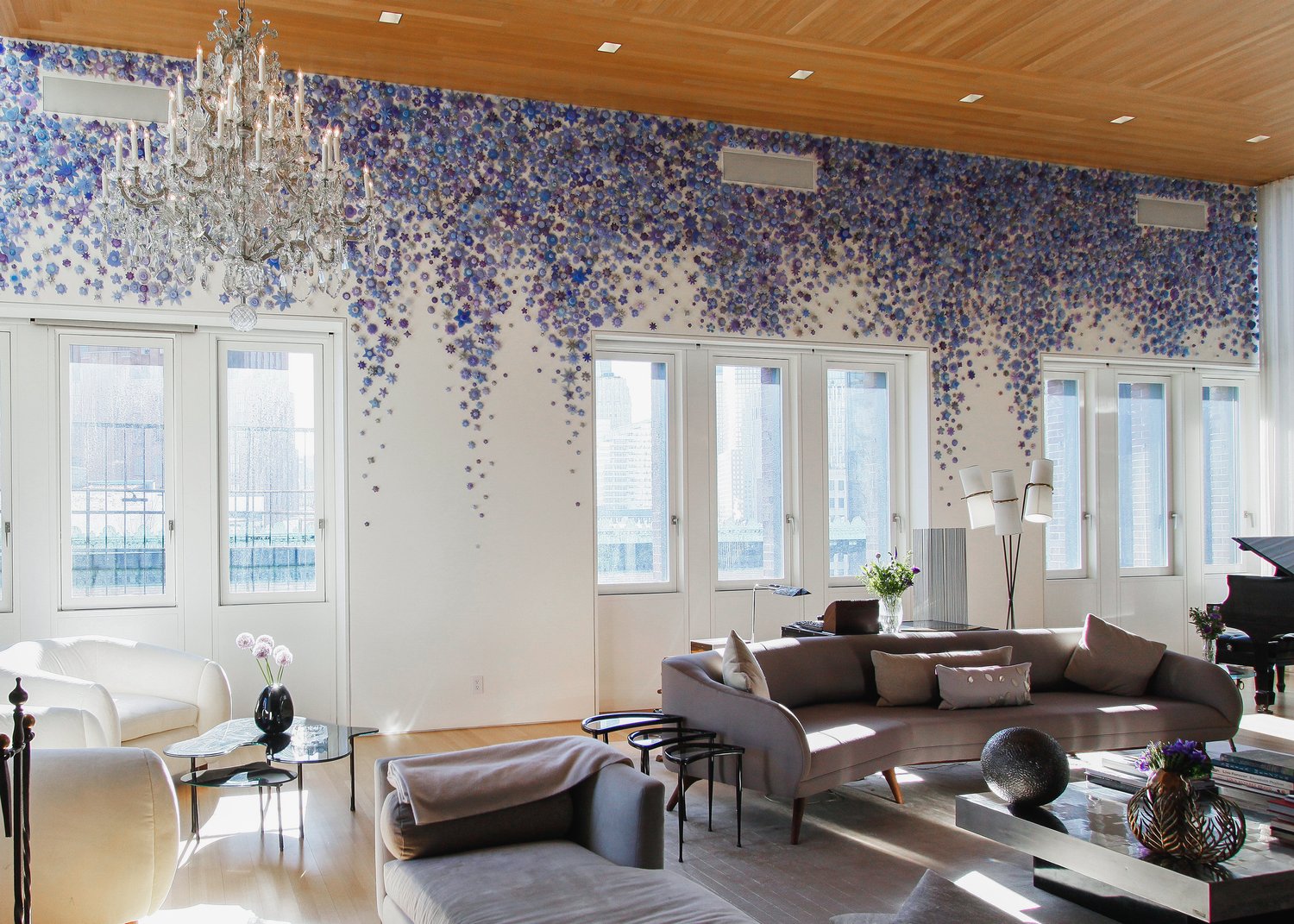
_VSCO.jpg?width=332&height=177&name=TMoss_Continuum%20Sliver%20copy%20(1)_VSCO.jpg)
